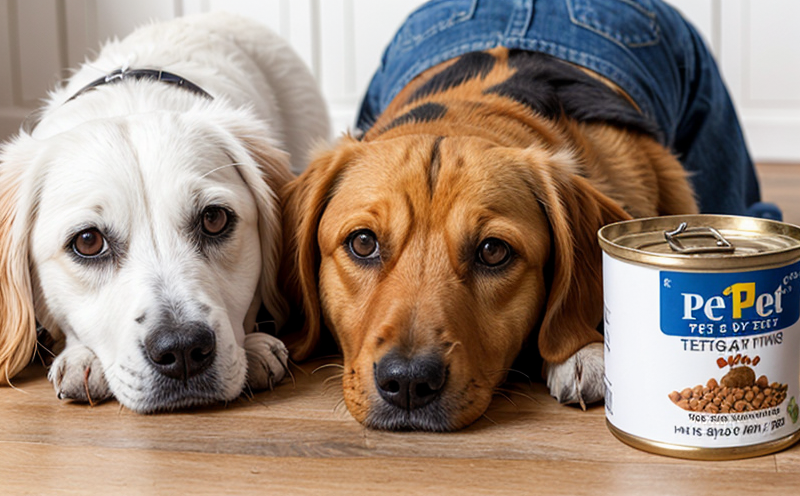ISO 77162 Preservative Residue Analysis in Pet Food
The ISO 77162 standard provides a method for determining preservative residues in pet food products. This service is critical for ensuring the safety and quality of pet foods, which are essential dietary components for pets worldwide. Compliance with this standard helps manufacturers meet regulatory requirements and maintain trust among consumers.
Preservatives play a vital role in extending the shelf life of pet food by inhibiting the growth of microorganisms such as bacteria, mold, and yeast. Common preservatives used in pet foods include but are not limited to BHA (Butylated Hydroxyanisole), BHT (Butylated Hydroxytoluene), and vitamin E. The presence of these compounds must be controlled to ensure the health and safety of pets.
The ISO 77162 method involves several key steps, including sample preparation, extraction, cleanup, and quantification using high-performance liquid chromatography (HPLC) with UV detection or mass spectrometry. The precision and accuracy of these analytical techniques are paramount in providing reliable data for regulatory compliance.
Our laboratory adheres strictly to the ISO 77162 protocol to ensure accurate results. We use state-of-the-art instrumentation, including a Thermo Fisher Scientific QQQ Mass Spectrometer and an Agilent HPLC system equipped with a UV detector, to perform these analyses. These instruments offer high sensitivity and selectivity necessary for detecting trace levels of preservatives.
The typical workflow includes the following steps:
- Sample collection: Fresh or reconstituted pet food samples are collected from various batches and locations within the production facility.
- Sample preparation: The samples are homogenized to ensure a representative mixture for analysis.
- Extraction: Preservatives are extracted using an appropriate solvent system, followed by cleanup steps to remove interfering components.
- Quantification: The purified extracts are analyzed using HPLC or mass spectrometry to determine the concentrations of preservatives present in the samples.
The results obtained from this analysis provide critical information about the presence and levels of preservatives, ensuring that pet food products meet safety standards established by regulatory bodies such as the FDA (Food and Drug Administration) and EU regulations.
Our team of experienced analysts ensures that each step in the process is conducted meticulously to deliver accurate and reliable results. We also offer additional services, including residual solvent analysis, which complements our preservative residue analysis capability by providing a comprehensive view of potential contaminants in pet food products.
Applied Standards
| Standard Number | Description |
|---|---|
| ISO 77162:2023 | Method for determining preservative residues in pet food products. |
Quality and Reliability Assurance
We maintain a robust quality management system to ensure the accuracy and reliability of our test results. Our laboratory is accredited by recognized bodies such as ISO/IEC 17025, ensuring compliance with international standards for technical competence in testing and calibration. This accreditation guarantees that our methods are validated and that our equipment is regularly calibrated.
Our analysts undergo continuous training to stay updated on the latest techniques and methodologies relevant to pet food testing. Regular internal audits and external evaluations further enhance our commitment to quality assurance. By adhering strictly to ISO 77162, we ensure that every test conducted meets the highest standards of precision and accuracy.
The reproducibility and repeatability of results are paramount in this field. Our laboratory maintains strict controls over all aspects of sample handling, preparation, and analysis to minimize variability. This ensures consistent and reliable data across multiple samples and batches.
Environmental and Sustainability Contributions
- Eco-friendly solvent systems: We employ solvents that are less harmful to the environment during extraction processes.
- Energy-efficient instruments: Our analytical equipment is designed with energy conservation in mind, reducing our carbon footprint.
- Waste minimization: By optimizing sample preparation and cleanup procedures, we minimize waste generation.
The ISO 77162 method itself contributes to environmental sustainability by helping manufacturers identify and control preservative residues effectively. This reduces the need for excessive use of preservatives, which can have negative environmental impacts if improperly managed.
Our commitment to sustainable practices extends beyond our laboratory operations. We work closely with clients to provide insights into how their testing results impact broader environmental considerations. By offering this service, we support a more responsible and environmentally conscious pet food industry.





